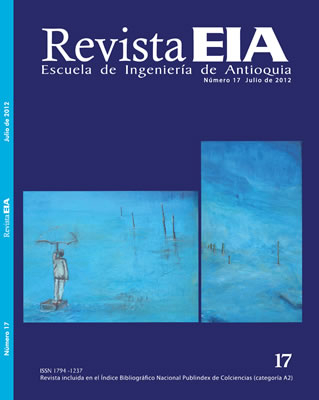DETERMINACIÓN DE LAS FRACCIONES SARA DE ASFALTOS COLOMBIANOS ENVEJECIDOS AL MEDIO AMBIENTE EMPLEANDO CROMATOGRAFÍA LÍQUIDA EN COLUMNA (DETERMINATION OF SARA FRACTIONS OF ENVIRONMENTALLY AGED COLOMBIAN ASPHALTS USING LIQUID CHROMATOGRAPHY COLUMN)
DETERMINACIÓN DE LAS FRACCIONES SARA DE ASFALTOS COLOMBIANOS ENVEJECIDOS AL MEDIO AMBIENTE EMPLEANDO CROMATOGRAFÍA LÍQUIDA EN COLUMNA (DETERMINATION OF SARA FRACTIONS OF ENVIRONMENTALLY AGED COLOMBIAN ASPHALTS USING LIQUID CHROMATOGRAPHY COLUMN)


This work is licensed under a Creative Commons Attribution-NonCommercial-NoDerivatives 4.0 International License.
Copyright statement
The authors exclusively assign to the Universidad EIA, with the power to assign to third parties, all the exploitation rights that derive from the works that are accepted for publication in the Revista EIA, as well as in any product derived from it and, in in particular, those of reproduction, distribution, public communication (including interactive making available) and transformation (including adaptation, modification and, where appropriate, translation), for all types of exploitation (by way of example and not limitation : in paper, electronic, online, computer or audiovisual format, as well as in any other format, even for promotional or advertising purposes and / or for the production of derivative products), for a worldwide territorial scope and for the entire duration of the rights provided for in the current published text of the Intellectual Property Law. This assignment will be made by the authors without the right to any type of remuneration or compensation.
Consequently, the author may not publish or disseminate the works that are selected for publication in the Revista EIA, neither totally nor partially, nor authorize their publication to third parties, without the prior express authorization, requested and granted in writing, from the Univeridad EIA.
Show authors biography
En este artículo presentamos un método basado en cromatografía líquida en columna para cuantificar la
composición química de los cementos asfálticos fabricados en Colombia, sometidos al medio ambiente, mediante la determinación de las fracciones SARA. El método fue aplicado sobre películas de asfalto 60/70 y 80/100 para determinar los cambios en la composición química del material luego de ser expuesto durante 12 meses a las condiciones de intemperie de la ciudad de Bogotá; los ensayos de SARA fueron efectuados para el asfalto original a 1, 3, 6, 9 y 12 meses respectivamente. Los fraccionamientos SARA evidenciaron que el envejecimiento produjo una disminución de la fracción de aromáticos y un incremento en la de asfaltenos respecto al asfalto no envejecido. La disminución de los compuestos aromáticos y de resinas pudo ser responsable del endurecimiento observado en los asfaltos, que presentaron una consistencia dura y quebradiza, lo que está de acuerdo con la obtención de
índices coloidales elevados. El método empleado permitió establecer correlaciones entre la composición química del asfalto y sus propiedades mecánicas.
Abstract: In this paper, we present a method based on liquid chromatography column to quantify the chemical composition of asphalt cements manufactured in Colombia, under the environment by determining the SARA fractions. The method was applied to thin layers of asphalt 60/70 and 80/100 to determine changes in the chemical composition of the material after exposure for 12 months in the weather conditions in the city of Bogotá; SARA tests were performed to the original asphalt, 1, 3, 6, 9 and 12 months aged respectively. SARA trials showed that aging caused a decrease in the fraction of aromatics and asphaltenes increased compared to non-aged asphalt. The reduction of aromatics and resins could be responsible for the hardening observed in the asphalt, which had a stiff and brittle consistency; that leads to obtaining higher colloidal index. The performed method established possible correlations between the chemical composition of asphalt and its mechanical properties.
Article visits 1492 | PDF visits 338
